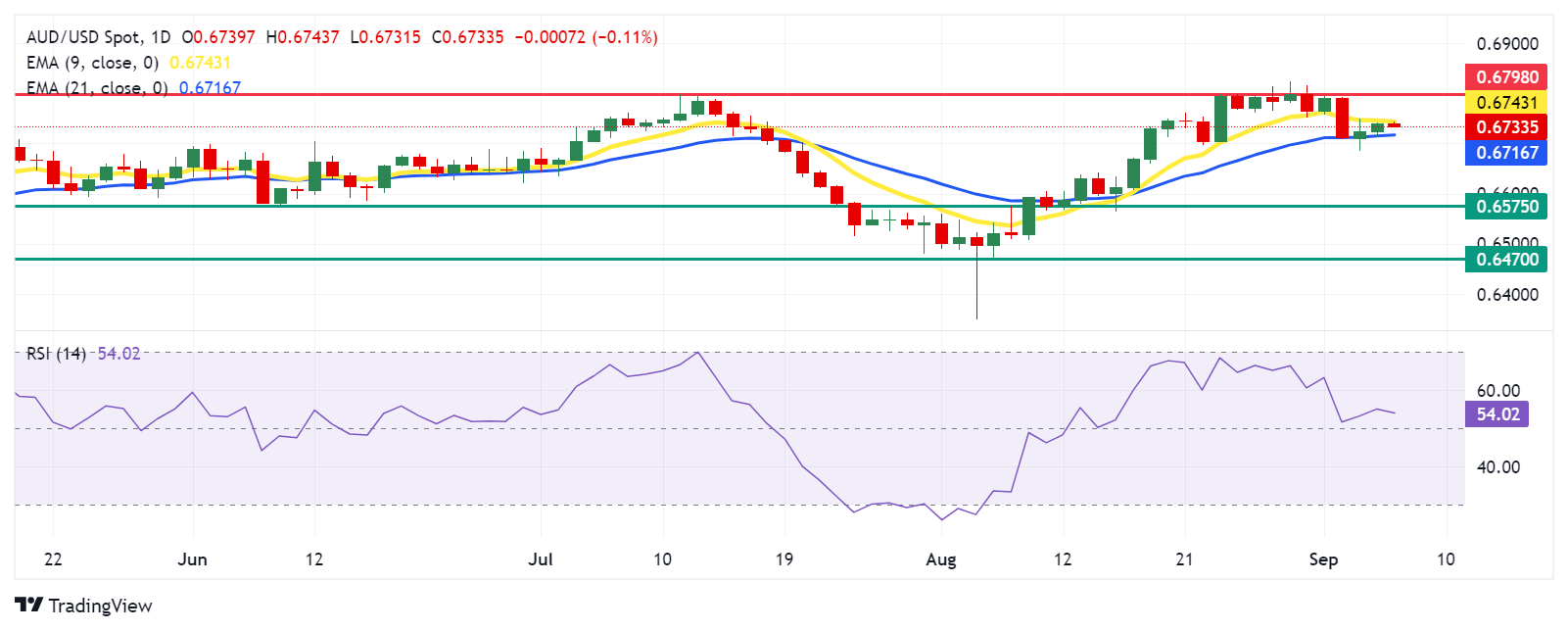- The Australian Dollar halted its two-day winning streak despite the hawkish RBA outlook.
- RBA Governor Michele Bullock stated that it is too early to consider rate cuts.
- The US Dollar extends its decline following the dovish Fedspeak.
The Australian Dollar (AUD) halts its two days of gains against the US Dollar (USD) as traders adopt caution ahead of the release of US Nonfarm Payrolls (NFP). This data may offer more cues on the potential size of an expected rate cut by the Federal Reserve (Fed) this month.
The Aussie Dollar received support from the positive Trade Balance data released on Thursday. Additionally, the Reserve Bank of Australia (RBA) Governor Michele Bullock spoke at “The Anika Foundation” in Sydney on “The Costs of High Inflation,” stating that it is too early to consider rate cuts. Currently, the board does not anticipate being able to reduce rates in the near term.
The US Dollar extends its decline following the dovish comments from the Fed officials. However, the positive key economic data might have limited the downside of the Greenback. US ISM Services PMI rose to 51.5 in August from 51.4 in July, above the market expectation of 51.1.
Chicago Fed President Austan Goolsbee said on Friday that the longer-run trend of the labor market and inflation data justify the Fed easing interest-rate policy soon and then steadily over the next year. FXStreet’s FedTracker, which gauges the tone of Fed officials’ speeches on a dovish-to-hawkish scale from 0 to 10 using a custom AI model, rated Goolsbee’s words as neutral with a score of 3.8.
Daily Digest Market Movers: Australian Dollar depreciates ahead of US Nonfarm Payrolls
- ADP Employment Change showed on Thursday that private-sector employment increased by 99,000 in August, following July’s increase of 111,000 and below the estimate of 145,000. Meanwhile, the weekly US Initial Jobless Claims rose to 227,000 for the week ending August 30, compared to the previous reading of 232,000 and below the initial consensus of 230,000.
- Australia’s trade surplus widened to 6,009 million MoM in July, exceeding the expected 5,150 million and 5,589 million in the previous reading.
- Atlanta Federal Reserve President Raphael Bostic said on Wednesday that the Fed is in a favorable position but added that they must not maintain a restrictive policy stance for too long, per Reuters. FXStreet’s FedTracker, which gauges the tone of Fed officials’ speeches on a dovish-to-hawkish scale from 0 to 10 using a custom AI model, rated Bostic’s words as neutral with a score of 4.6.
- US JOLTS Job Openings dropped to 7.673 million in July, down from 7.910 million in June, marking the lowest level since January 2021 and falling short of market expectations of 8.10 million.
- Bank of America (BoA) has revised its economic growth forecast for China, lowering its 2024 projection to 4.8% from the previous 5.0%. For 2025, the forecast is adjusted to 4.5% growth, while the 2026 outlook remains unchanged at 4.5%.
- Australia’s Gross Domestic Product (GDP) posted a 0.2% reading QoQ for the second quarter, up from the previous quarter’s 0.1% but falling short of the expected 0.3% readings.
- The Judo Bank Composite PMI climbed to 51.7 in August, up from 51.4 in July, signaling the fastest expansion in three months. This growth was primarily fueled by a rise in services activity, with the Services PMI reaching 52.5 in August, up from 52.2 in July, marking the seventh consecutive month of growth in the services sector.
- The US ISM Manufacturing PMI inched up to 47.2 in August from 46.8 in July, falling short of market expectations of 47.5. This marks the 21st contraction in US factory activity over the past 22 months.
Technical Analysis: Australian Dollar holds position above 50-day EMA near 0.6700
The Australian Dollar is trading around 0.6740 on Friday. On the daily chart, the AUD/USD pair is positioned below the nine-day Exponential Moving Average (EMA), indicating a short-term bearish trend. However, the 14-day Relative Strength Index (RSI) is slightly above 50, hinting at a possible bullish inclination. A drop below the 50 level on the RSI could confirm a bearish shift.
On the downside, the AUD/USD pair could test immediate support around the 50-day EMA at 0.6716 level. A break below this level could reinforce the bearish bias and lead the pair to navigate the region around the throwback level near 0.6575, with a deeper decline potentially aiming for the lower support around 0.6470.
Regarding resistance, the AUD/USD pair is testing the nine-day EMA at 0.6743. A break above this level could open the door for a potential retest of the seven-month high at 0.6798.
AUD/USD: Daily Chart

Australian Dollar PRICE Today
The table below shows the percentage change of Australian Dollar (AUD) against listed major currencies today. Australian Dollar was the weakest against the Japanese Yen.
| USD | EUR | GBP | JPY | CAD | AUD | NZD | CHF | |
|---|---|---|---|---|---|---|---|---|
| USD | -0.02% | 0.02% | -0.17% | -0.04% | 0.12% | 0.14% | -0.05% | |
| EUR | 0.02% | 0.03% | -0.14% | -0.04% | 0.14% | 0.14% | -0.05% | |
| GBP | -0.02% | -0.03% | -0.17% | -0.05% | 0.12% | 0.12% | -0.07% | |
| JPY | 0.17% | 0.14% | 0.17% | 0.14% | 0.30% | 0.29% | 0.10% | |
| CAD | 0.04% | 0.04% | 0.05% | -0.14% | 0.16% | 0.19% | -0.02% | |
| AUD | -0.12% | -0.14% | -0.12% | -0.30% | -0.16% | 0.00% | -0.19% | |
| NZD | -0.14% | -0.14% | -0.12% | -0.29% | -0.19% | -0.00% | -0.20% | |
| CHF | 0.05% | 0.05% | 0.07% | -0.10% | 0.02% | 0.19% | 0.20% |
The heat map shows percentage changes of major currencies against each other. The base currency is picked from the left column, while the quote currency is picked from the top row. For example, if you pick the Australian Dollar from the left column and move along the horizontal line to the US Dollar, the percentage change displayed in the box will represent AUD (base)/USD (quote).
Economic Indicator
ISM Services PMI
The Institute for Supply Management (ISM) Services Purchasing Managers Index (PMI), released on a monthly basis, is a leading indicator gauging business activity in the US services sector, which makes up most of the economy. The indicator is obtained from a survey of supply executives across the US based on information they have collected within their respective organizations. Survey responses reflect the change, if any, in the current month compared to the previous month. A reading above 50 indicates that the services economy is generally expanding, a bullish sign for the US Dollar (USD). A reading below 50 signals that services sector activity is generally declining, which is seen as bearish for USD.
Read more.

























